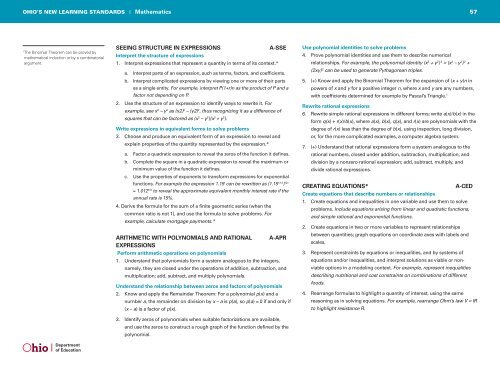Math-Standards.pdf
Math-Standards.pdf
Math-Standards.pdf
You also want an ePaper? Increase the reach of your titles
YUMPU automatically turns print PDFs into web optimized ePapers that Google loves.
OHIO’S NEW LEARNING STANDARDS I <strong>Math</strong>ematics 57<br />
1<br />
The Binomial Theorem can be proved by<br />
mathematical induction or by a combinatorial<br />
argument.<br />
SEEING STRUCTURE IN EXPRESSIONS<br />
A-SSE<br />
Interpret the structure of expressions<br />
1. Interpret expressions that represent a quantity in terms of its context.*<br />
a. Interpret parts of an expression, such as terms, factors, and coefficients.<br />
b. Interpret complicated expressions by viewing one or more of their parts<br />
as a single entity. For example, interpret P(1+r)n as the product of P and a<br />
factor not depending on P.<br />
2. Use the structure of an expression to identify ways to rewrite it. For<br />
example, see x 4 – y 4 as (x2) 2 – (y2) 2 , thus recognizing it as a difference of<br />
squares that can be factored as (x 2 – y 2 )(x 2 + y 2 ).<br />
Write expressions in equivalent forms to solve problems<br />
3. Choose and produce an equivalent form of an expression to reveal and<br />
explain properties of the quantity represented by the expression.*<br />
a. Factor a quadratic expression to reveal the zeros of the function it defines.<br />
b. Complete the square in a quadratic expression to reveal the maximum or<br />
minimum value of the function it defines.<br />
c. Use the properties of exponents to transform expressions for exponential<br />
functions. For example the expression 1.15 t can be rewritten as (1.15 1/12 ) 12t<br />
≈ 1.012 12t to reveal the approximate equivalent monthly interest rate if the<br />
annual rate is 15%.<br />
4. Derive the formula for the sum of a finite geometric series (when the<br />
common ratio is not 1), and use the formula to solve problems. For<br />
example, calculate mortgage payments.*<br />
ARITHMETIC WITH POLYNOMIALS AND RATIONAL A-APR<br />
EXPRESSIONS<br />
Perform arithmetic operations on polynomials<br />
1. Understand that polynomials form a system analogous to the integers,<br />
namely, they are closed under the operations of addition, subtraction, and<br />
multiplication; add, subtract, and multiply polynomials.<br />
Understand the relationship between zeros and factors of polynomials<br />
2. Know and apply the Remainder Theorem: For a polynomial p(x) and a<br />
number a, the remainder on division by x – a is p(a), so p(a) = 0 if and only if<br />
(x – a) is a factor of p(x).<br />
3. Identify zeros of polynomials when suitable factorizations are available,<br />
and use the zeros to construct a rough graph of the function defined by the<br />
polynomial.<br />
Use polynomial identities to solve problems<br />
4. Prove polynomial identities and use them to describe numerical<br />
relationships. For example, the polynomial identity (x 2 + y 2 ) 2 = (x 2 – y 2 ) 2 +<br />
(2xy) 2 can be used to generate Pythagorean triples.<br />
5. (+) Know and apply the Binomial Theorem for the expansion of (x + y)n in<br />
powers of x and y for a positive integer n, where x and y are any numbers,<br />
with coefficients determined for example by Pascal’s Triangle. 1<br />
Rewrite rational expressions<br />
6. Rewrite simple rational expressions in different forms; write a(x)/b(x) in the<br />
form q(x) + r(x)/b(x), where a(x), b(x), q(x), and r(x) are polynomials with the<br />
degree of r(x) less than the degree of b(x), using inspection, long division,<br />
or, for the more complicated examples, a computer algebra system.<br />
7. (+) Understand that rational expressions form a system analogous to the<br />
rational numbers, closed under addition, subtraction, multiplication, and<br />
division by a nonzero rational expression; add, subtract, multiply, and<br />
divide rational expressions.<br />
CREATING EQUATIONS*<br />
A-CED<br />
Create equations that describe numbers or relationships<br />
1. Create equations and inequalities in one variable and use them to solve<br />
problems. Include equations arising from linear and quadratic functions,<br />
and simple rational and exponential functions.<br />
2. Create equations in two or more variables to represent relationships<br />
between quantities; graph equations on coordinate axes with labels and<br />
scales.<br />
3. Represent constraints by equations or inequalities, and by systems of<br />
equations and/or inequalities, and interpret solutions as viable or nonviable<br />
options in a modeling context. For example, represent inequalities<br />
describing nutritional and cost constraints on combinations of different<br />
foods.<br />
4. Rearrange formulas to highlight a quantity of interest, using the same<br />
reasoning as in solving equations. For example, rearrange Ohm’s law V = IR<br />
to highlight resistance R.


